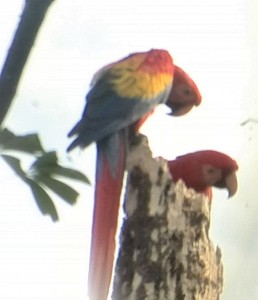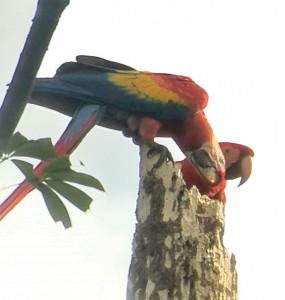The Return of the Scarlet Macaws
By Jack Ewing
 “There used to be so many of them that the branches of the trees would sag with their weight,” commented one old timer. “They used to love a big old kapok tree on Hacienda Barú near the road to the beach. It was hollow and some of them nested there.”
“There used to be so many of them that the branches of the trees would sag with their weight,” commented one old timer. “They used to love a big old kapok tree on Hacienda Barú near the road to the beach. It was hollow and some of them nested there.”
“What happened to them?” I asked.
“People shot them. I remember one guy who shot a whole mess of them. He had a 22 rifle and just picked them off one at a time right out of the tree where they roosted.”
“Why did he shoot them?”
“Some people did it for the feathers, but that guy did it just for the fun of seeing them fall. I haven’t seen a guacamayo in these parts since the 1960s. Now that I think back on it, it seems like they disappeared overnight. It wasn’t a gradual thing. One day everybody noticed that there weren’t any more of them. Those that didn’t get shot just left.”

Although the man who told me this didn’t mention it, relentless hunting wasn’t the only cause of the disappearance of the scarlet macaws, called lapa roja or guacamayo in Spanish. Habitat loss was at least as important. In the 60s and 70s cattle ranching thrived on the south pacific coast of Costa Rica. The production of beef for export to the fast-food industry in North America was the most important source of income and employment in the zone. It also brought about the mass deforestation that along with uncontrolled hunting resulted in the disappearance of the tapir, white-lipped peccary, jaguar, and scarlet macaw, among others. In those days wildlife protection laws were lax or non-existent, and the conservation ethic had not yet been born. “Go to the wild lands, cut down the forests,” said the government, “and make the land produce.” And, that’s what the people did.
“ I grew up during the 60s,” says Juan Ramón, “and I don’t ever remember seeing a lapa roja. When I finished grade school my papa gave me an ax and a machete. I guess you could call it a graduation present. He taught me how to use it too, to cut down a tree. There’s no easy way to fell a tree with an ax. It’s one blow at a time. By the time I was 20 my papa and I had felled and burned 50 hectares of rainforest on the farm in Lagunas. We had enough pasture for 50 head of cattle. Ten hectares of forest was all that was left.”
 By 1985 things were starting to change. According the the forestry department, that was the year that deforestation peaked. A number of factors combined to take the big profit out of cattle ranching, and property owners started looking for other ways to use their land. A gradual influx of foreigners interested in acquiring property led to an upward curve in land prices. Many former ranchers were ready and anxious to sell. The new buyers weren’t interested in raising cows, they wanted to live in a natural environment. Also tourism was on the rise, and tourists wanted to see monkeys and toucans, not cows. Most of the new land owners let the pastures regenerate into secondary forest. In the tropics, when you quit chopping the weeds, the jungle comes back with a vengeance, and that’s what it did.
By 1985 things were starting to change. According the the forestry department, that was the year that deforestation peaked. A number of factors combined to take the big profit out of cattle ranching, and property owners started looking for other ways to use their land. A gradual influx of foreigners interested in acquiring property led to an upward curve in land prices. Many former ranchers were ready and anxious to sell. The new buyers weren’t interested in raising cows, they wanted to live in a natural environment. Also tourism was on the rise, and tourists wanted to see monkeys and toucans, not cows. Most of the new land owners let the pastures regenerate into secondary forest. In the tropics, when you quit chopping the weeds, the jungle comes back with a vengeance, and that’s what it did.
Additionally the 1980s was the decade when Costa Ricans started worrying about the environment. An environmental movement was born, matured, thrived, and is still going strong today. Locally the organization Amigos de la Naturaleza (ASANA) came into being in 1987. At first the group just tried to stop people from hunting, but later they started doing environmental education in the local schools and trying to rescue the marine turtles.
In 1990 ASANA initiated a project designed to restore habitat and create natural connections between rainforests in the region. It was called the Path of the Tapir Biological Corridor (PTBC.) Though the project has not yet realized its ultimate goal of bringing back tapirs to the zone, it has had a certain amount of success. The natural habitat in the zone has more than doubled since the project began. There are now five national wildlife refuges, one national park, and at least 30 private nature reserves within the corridor. In 1997 the spider monkeys returned to Hacienda Barú. Squirrel monkeys and howler monkeys are migrating to areas where they haven’t been seen for over half a century. Trail cameras placed at different locations within the PTBC, often capture photos of pumas, and ocelots. Every year new bird species appear. The namesake, the tapir, has been sighted in several places, as have jaguars.
In 2000 a wildlife rescue center in Manuel Antonio closed its doors and released a number of animals into the wild to the south of Quepos, among them were 21 scarlet macaws. These semi-domestic macaws were released into the forest without much prior conditioning and have had difficulties learning the ways of the wild. Some of the birds and tried to nest in people’s houses. These pairs often became very aggressive with the people. Nevertheless a number of pairs have reproduced, and established themselves in the rainforests around a place called El Silencio, located on the northern end of the PTBC. In the last few years their descendants have extended their range to the south. At the same time macaws from the Osa Peninsula, to the south of Hacienda Barú, have been migrating northward along the corridor.
When I first came to Hacienda Barú in 1972 all of the lowland except the mangrove, had been deforested. About 160 hectares of primary forest remained in the higher elevations of the hacienda. In 1979 we began the process of restoring rainforest to the denuded lands. In 1987 we began taking ecological tourists and bird watchers on hikes through the rainforest. In that same year we began listing all of the species of birds, mammals, amphibians, and reptiles we sighted and identified. As natural habitat regenerated in former pastures the list grew until today it contains 366 species of birds, about 40% as many as there are in all of North America. Scarlet macaws are one of the newest additions to the list.
In the late 1990s we were approached by an animal refuge that had about a 100 macaws that were suitable for release into the wild. They offered to work with us over the next few years to reintroduce a number of birds at Hacienda Barú. The project consisted of building a very large cage in the middle of the rainforest and enclosing the birds there for a six-month period. During that time they would have a minimum of contact with humans and would eat only foods that could be readily acquired in the wild. Then they would be released two at a time over a period of another two or three months. Once they were all living as nature intended we would bring in another six pairs and begin the process again. Though the idea of having the big, red, blue, and yellow birds flying around Hacienda Barú was very tempting we finally decided not to carry out the project. We had already seen that the biological corridor was functioning, and we figured the birds would eventually come here by themselves. That is now beginning to happen.
In February of 2011 a group of about 30 scarlet macaws appeared one morning. Many people on Hacienda Barú and neighboring properties saw them. Since that time the impressive birds have made sporadic appearances in groups of two to four. Sightings by guests and personnel occur about three times each week. To date all of the sightings have been in the lowlands. Scarlet macaws eat the seeds of teak trees and almond trees, and both of these species are found here, teak in a small plantation, and almond trees grow naturally along the beach. We haven’t yet sighted them in the primary forests of the highlands where most of the big, old nesting trees are found.
The old timer quoted at the beginning of this article mentioned a big, old kapok tree where the macaws used to nest. That tree had been there as long as anybody could remember. It finally fell in August of 1989. One day in mid July 2014 a pair of scarlet macaws landed in another large kapok tree near the restaurant. Ironically this tree is rooted within 50 meters of the tree where the macaws used to nest, and is probably a descendant. Though only about 30-years-old the tree is over 30 meters tall with a very large trunk. It was struck by lightning a couple of years ago, and the uppermost portion of trunk is dead. The dead part is where the macaws landed. Several of the guides fixed a telescope on the big birds, held their phones up to the eye-piece, and took the photos shown here. through the scope.
This pair of macaws has been returning to the same tree once or twice each week. Their behavior suggests that they may be scouting out nesting sights. Needless to say we are elated by this news and are keeping our fingers crossed.
Jack Ewing was born and educated in Colorado. In 1970 he and his wife Diane moved to the jungles of Costa Rica where they raised two children, Natalie and Chris. A newfound fascination with the rainforest was responsible for his transformation from cattle rancher into environmentalist and naturalist. His many years of living in the rainforest have rendered a multitude of personal experiences, many of which are recounted in his published collection of essays, Monkeys are Made of Chocolate. Jack and Diane live on and manage the Hacienda Barú National Wildlife Refuge, a well-known ecotourism destination on the southwest coast of Costa Rica.
